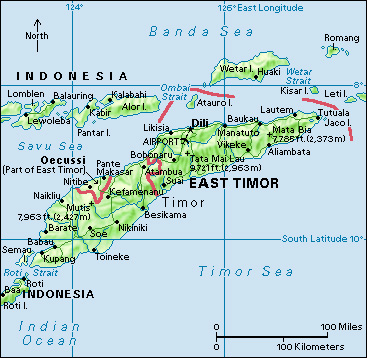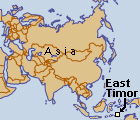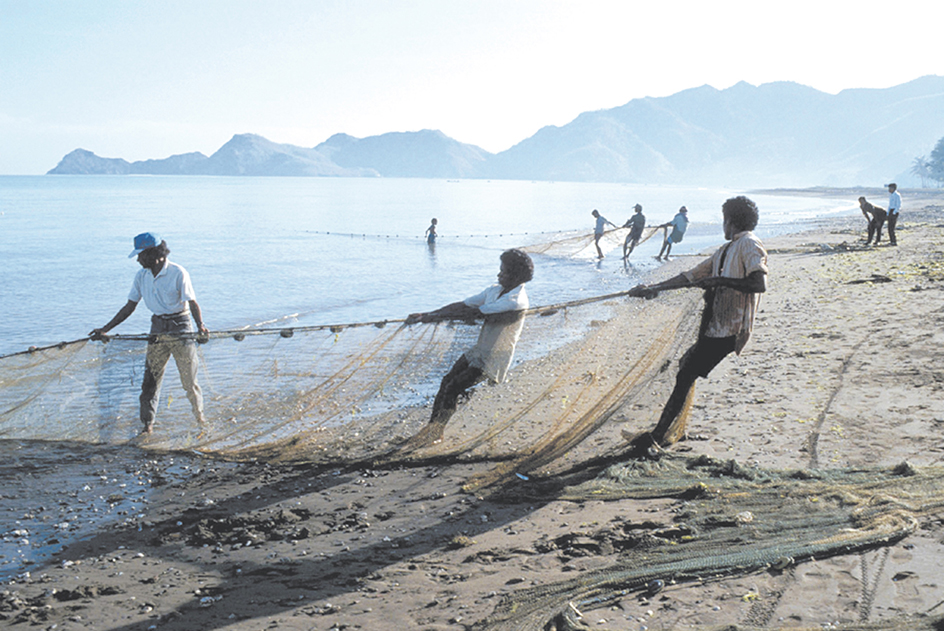East Timor << TEE mawr or tee MAWR >>, also called Timor-Leste, is a small country in Southeast Asia. It occupies the eastern side of the island of Timor. The island lies in the Timor Sea, about 300 miles (480 kilometers) north of Australia. Dili is East Timor’s capital and largest city. The country’s official name is the Democratic Republic of East Timor.

Portugal began trading in East Timor during the 1500’s and gradually established control of the region. After the Portuguese withdrew in 1975, Indonesia invaded and occupied East Timor. In 1999, the East Timorese voted overwhelmingly for independence. That same year, the United Nations (UN) began administering East Timor and helping it prepare for full independence. East Timor became independent on May 20, 2002.
Government.
East Timor is a republic with a multiparty political system. The president, who is head of state and supreme commander of the armed forces, is elected by the people to a five-year term. The party or group of parties with the most seats in the National Parliament, the nation’s legislature, chooses a prime minister to head the government. Like the president, members of the National Parliament are elected to five-year terms. East Timor is divided into 13 districts for purposes of local government. The Supreme Court of Justice is the nation’s highest court.

People.
East Timor’s two official languages are Tetum and Portuguese. But more than a dozen local languages are spoken, as well as Bahasa Indonesia and English. Although the East Timorese belong to a number of separate ethnic groups, most of the people are of Malay or Melanesian ancestry. Some East Timorese are descendants of Portuguese settlers.
Most of the people are Roman Catholics, and the Catholic Church plays a central role in cultural and political life. Some East Timorese practice variations of traditional religions along with Catholicism.
Land.
Most of East Timor lies on the eastern side of the island of Timor. The rest of the island of Timor belongs to Indonesia. East Timor also includes the mountainous region of Oecussi in western Timor and the small tropical islands of Atauro and Jaco. Much of East Timor’s territory is rugged and mountainous. However, the coastal plains in the south and parts of the north are fertile. The country’s highest point, Tata Mai Lau, is south of Dili. It rises 9,721 feet (2,963 meters).

Daytime temperatures average about 75 °F (24 °C) throughout the year, with cooler temperatures at higher altitudes. Monsoon winds produce distinct wet and dry seasons. In the north, the wet season normally lasts from December to April. Rainfall is typically heavier, and the wet season longer, in the south.
Economy.
East Timor is a developing country. Oil and natural gas reserves in the Timor Sea are important to the country’s economy. Income from the oil and natural gas industry finances most of the government’s budget. Manufacturing plays a small role in the country’s economy.
Agriculture accounts for much of East Timor’s economic production. More than half of East Timor’s workers are farmers. Corn and rice are the leading food crops. Coffee is the leading cash crop. Farmers also grow cassava, mangoes, and sweet potatoes. Buffalo, cattle, and hogs are raised for meat. Fishing is also important to East Timor.

Dili is the country’s main port. East Timor imports much more than it exports. The country’s main imports include food, machinery, motor vehicles, and petroleum products. The country exports coffee and oil. East Timor’s main trading partners include Australia, China, Indonesia, and Singapore.
History.
People have lived on the island of Timor for thousands of years. Sandalwood from Timor was traded throughout Asia in ancient times.
East Timor national anthem
In the 1500’s, Portugal began to trade with the people of Timor. Portugal gradually gained control of the eastern part of the island in the 1600’s and 1700’s. Meanwhile, the Netherlands gained control of the western part of the island and most of what is now Indonesia. In 1859, Portugal and the Netherlands agreed to divide the island under the Treaty of Lisbon. East Timor became a colony of Portugal, called Portuguese Timor, in 1896.
In 1942, during World War II, Japan occupied Timor. In 1945, at the end of the war, control of East Timor returned to Portugal.
In 1975, Portugal withdrew from East Timor and a brief civil war erupted. One of the parties in the conflict, the Revolutionary Front for an Independent East Timor (FRETILIN), declared East Timor’s independence in November 1975. In December, Indonesia, which already possessed the western part of the island, sent military troops to take control of the eastern section. In July 1976, Indonesia annexed East Timor as its 27th province, but its authority there was never accepted by the United Nations.
Many people in East Timor resisted Indonesian rule. During this period, as many as 200,000 East Timorese died, many from starvation and disease. In the 1990’s, the United States and other nations joined nongovernmental organizations in accusing Indonesia of human rights violations. In 1996, Carlos Ximenes Belo, the Roman Catholic Bishop of Dili, and José Ramos-Horta, the international spokesman for the independence movement, won the Nobel Peace Prize for their efforts to secure a just settlement of the conflict.
In 1999, Indonesia proposed that the East Timorese should vote on whether they favored independence or a form of autonomy (self-government) under Indonesian rule. Almost 80 percent of East Timor’s people voted for independence in the referendum, which took place in August 1999. After the vote, opponents of independence, assisted by the Indonesian armed forces, launched a campaign of terror against the East Timorese. The violence left at least 1,000 people dead and destroyed much of East Timor’s infrastructure (public buildings, roads, and utilities). At least 250,000 residents were forced into refugee camps in Indonesia.
In September 1999, the UN sent an Australian-led multinational military force to East Timor to stop the violence. In October, Indonesia’s legislature voted to end Indonesia’s claim to the territory. The UN, together with East Timorese leaders, began administering the region.
In 2001, 16 political parties competed in elections for an 88-member Constituent Assembly. The former resistance group FRETILIN won a majority of Assembly seats. The Assembly completed and approved a new constitution in early 2002. In April 2002, the long-time resistance leader José Alexandre Gusmão, commonly known as Xanana Gusmão, was elected president by the people of East Timor. Full political power was transferred to the new government on May 20. Following independence, the Assembly became the country’s first parliament. Mari Alkatiri, the leader of the Assembly, became prime minister.
In February 2006, hundreds of soldiers from eastern East Timor went on strike to protest alleged discrimination by officers from western East Timor. In response, the government fired more than a third of the army. The fired soldiers rioted in the capital city, Dili. In May, the violence grew to include gang warfare, and more than 20 people were killed. Australia, New Zealand, and other nations sent peacekeeping forces to East Timor to help control the violence. In June, Prime Minister Mari Alkatiri resigned after his critics blamed him for the crisis. In July, Ramos-Horta became prime minister. In September, the UN took control of the peacekeeping forces. By the end of 2012, the international peacekeepers, satisfied with the progress made in East Timor, withdrew from the country.
In May 2007, Ramos-Horta was elected president in a runoff election. In June 2007, legislative elections were held, but no party won a majority of seats. Xanana Gusmão, the former president, became prime minister.
In February 2008, rebels attacked President Ramos-Horta and Prime Minister Gusmão in their homes during a failed coup attempt. Gusmão was not injured, but Ramos-Horta was critically wounded and hospitalized for two months. After the attacks, the government declared emergency rule to prevent further violence. The government lifted emergency rule in April. Former guerrilla fighter Taur Matan Ruak was elected president in 2012 and served until 2017. In 2017, Francisco Guterres, another former guerrilla fighter, was elected to the presidency. In 2022, former president Ramos-Horta was elected president again.
